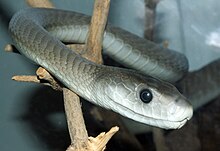
Back Swartmamba Afrikaans Blæc hrædsnaca ANG ممبة سوداء Arabic مامبا سوداء ARZ Чорная мамба Byelorussian Чорная мамба BE-X-OLD Черна мамба Bulgarian কালো মাম্বা Bengali/Bangla Mamba negra Catalan Dendroaspis polylepis CEB
| Black mamba | |
|---|---|

| |
| Scientific classification | |
| Domain: | Eukaryota |
| Kingdom: | Animalia |
| Phylum: | Chordata |
| Class: | Reptilia |
| Order: | Squamata |
| Suborder: | Serpentes |
| Family: | Elapidae |
| Genus: | Dendroaspis |
| Species: | D. polylepis
|
| Binomial name | |
| Dendroaspis polylepis | |

| |
| Distribution range of black mamba in red (grey areas are inconclusive) | |
| Synonyms[3] | |
|
List
| |
The black mamba (Dendroaspis polylepis) is a species of highly venomous snake belonging to the family Elapidae. It is native to parts of sub-Saharan Africa. First formally described by Albert Günther in 1864, it is the second-longest venomous snake after the king cobra; mature specimens generally exceed 2 m (6 ft 7 in) and commonly grow to 3 m (9.8 ft). Specimens of 4.3 to 4.5 m (14 to 15 ft) have been reported. Its skin colour varies from grey to dark brown. Juvenile black mambas tend to be paler than adults and darken with age. Despite the common name, the skin of a black mamba is not black, but rather describes the inside of its mouth, which it displays when feeling threatened.
The species is both terrestrial (ground-living) and arboreal (tree-living); it inhabits savannah, woodland, rocky slopes and in some regions, dense forest. It is diurnal and is known to prey on birds and small mammals. Over suitable surfaces, it can move at speeds up to 16 km/h (10 mph) for short distances. Adult black mambas have few natural predators.
In a threat display, the black mamba usually opens its inky-black mouth, spreads its narrow neck-flap and sometimes hisses. It is capable of striking at considerable range and may deliver a series of bites in rapid succession. Its venom is primarily composed of neurotoxins that often induce symptoms within ten minutes, and is frequently fatal unless antivenom is administered. Despite its reputation as a formidable and highly aggressive species, the black mamba attacks humans only if it is threatened or cornered. It is rated as least concern on the International Union for Conservation of Nature (IUCN)'s Red List of Threatened Species.
- ^ Branch, W.R.; Trape, J.-F.; Luiselli, L.; Spawls, S.; Penner, J.; Howell, K.; Msuya, C.A.; Ngalason, W. (2021). "Dendroaspis polylepis". IUCN Red List of Threatened Species. 2021: e.T177584A15627370. doi:10.2305/IUCN.UK.2021-2.RLTS.T177584A15627370.en. Retrieved 19 November 2021.
- ^ "Dendroaspis polylepis". Integrated Taxonomic Information System. Retrieved 12 December 2013.
- ^ Uetz, Peter; Hallermann, Jakob. "Dendroaspis polylepis Günther, 1864". Reptile Database. Archived from the original on 29 October 2015. Retrieved 10 September 2018.
© MMXXIII Rich X Search. We shall prevail. All rights reserved. Rich X Search
